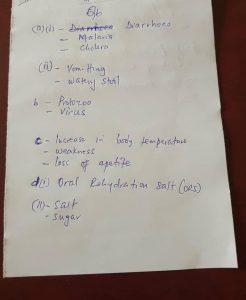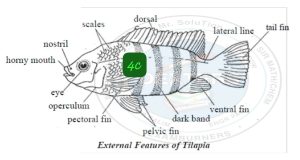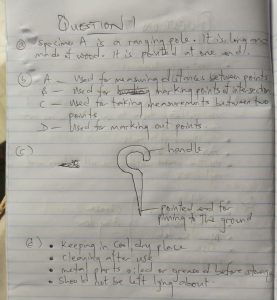Agriculture Waec Practical Answers 2024



(3a)
H: Chewing mouthparts.
J : Chewing mouthparts.
K: Piercing and sucking mouthparts.
(3b)
Effects of Specimen H on crop production:
(PICK ANY THREE)
(i) Damage to stored maize grains.
(ii) Reduction in grain quality and quantity.
(iii) Economic losses to farmers and storage facilities.
(iv) Risk of mycotoxin contamination due to fungal growth facilitated by weevil infestation.
(v) Decreased market value of infested maize.
Effects of Specimen J on crop production:
(PICK ANY THREE)
(i) Defoliation of plants
(ii) Reduction in crop yield
(iii) Damage to young seedlings
(iv) Increased plant susceptibility to diseases
(v) Decreased quality of harvested produce
(3c)
(PICK ANY THREE)
(i) Proper sanitation by keeping the store clean and free from spilled grains.
(ii) Regular inspection of stored maize for signs of infestation.
(iii) Use of hermetic storage methods such as airtight containers or bags to suffocate the weevils.
(iv) Application of chemical insecticides approved for grain storage, following recommended dosage and safety precautions.
(v) Employing physical control measures such as freezing or heating the infested maize to kill the weevils and their eggs.
(3d)
(PICK ANY THREE)
(i) Okra
(ii) Hibiscus
(iii) Eggplant
(iv) Bell peppers
(iv) Tomatoes




(3a)
H: Chewing mouthparts.
J : Chewing mouthparts.
K: Piercing and sucking mouthparts.
(3b)
Effects of Specimen H on crop production:
(i) Damage to stored maize grains.
(ii) Reduction in grain quality and quantity.
(iii) Economic losses to farmers and storage facilities.
Effects of Specimen J on crop production:
(i) Defoliation of plants
(ii) Reduction in crop yield
(iii) Damage to young seedlings
(3c)
(i) Proper sanitation by keeping the store clean and free from spilled grains.
(ii) Regular inspection of stored maize for signs of infestation.
(iii) Use of hermetic storage methods such as airtight containers or bags to suffocate the weevils.
(3d)
(i) Okra
*NUMBER TWO*
(2a)
The aim of the experiment is to determine the capillary rise of water in dry sand, dry clay, and dry loam.
(2b)
E: Least rise
F: Moderate rise
G: Highest rise
(2c)
(PICK TWO ONLY)
(i) The rise is influenced by soil type.
(ii) Loam has the highest capillary rise due to its texture.
(iii) Clay exhibits moderate capillary action.
(iv) Sand shows the least capillary rise.
(v) Soil particle size affects capillary action.
(vi) Water retention varies with soil composition.
(2d)
(PICK ONE ONLY)
(i) Prevents soil particles from escaping.
(ii) Acts as a barrier to maintain separation.
(iii) Facilitates water absorption evenly.
(iv) Maintains consistency in the experiment setup.
(v) Absorbs excess water to avoid spillage.
(2ei)
The soil in the capillary tube labelled E is best for agriculture.
(2eii)
(PICK TWO ONLY)
(i) Good drainage properties that prevent waterlogging and allow for proper aeration of plant roots.
(ii) High permeability that allows roots to easily penetrate the soil for nutrient uptake.
(iii) Low water retention which helps prevent root rot in plants.
(iv) Easy cultivation and good soil structure for root growth.
(v) Suitable for crops that require well-drained soil conditions.
(vi) Less prone to compaction, promoting healthy root development.
(2f)
Draw the diagram
(ii) Hibiscus
(iii) Eggplant
